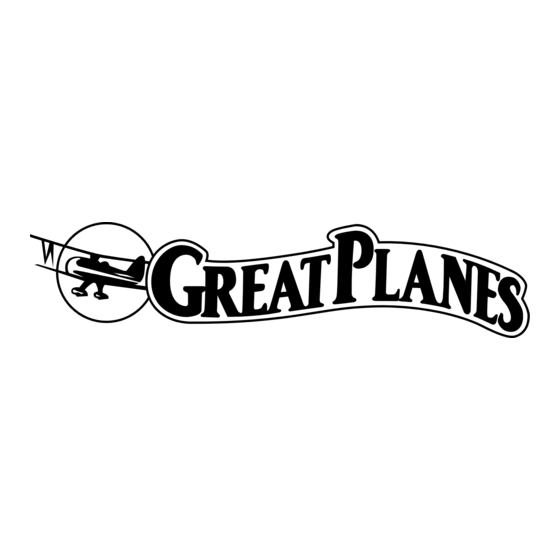GREAT PLANES FW-190 Focke Wulf Руководство по эксплуатации - Страница 16
Просмотреть онлайн или скачать pdf Руководство по эксплуатации для Игрушка GREAT PLANES FW-190 Focke Wulf. GREAT PLANES FW-190 Focke Wulf 20 страниц.

CHECK LIST
During the last few moments of preparation your mind may
be elsewhere anticipating the excitement of the first flight.
Because of this, you may be more likely to overlook certain
checks and procedures that should be performed before the
model is flown. To help avoid this, a check list is provided to
make sure these important areas are not overlooked. Many
are covered in the instruction manual, so where appropriate
refer to the manual for complete instructions. Be sure to
check the items off as they are completed.
❏
1. Check the C.G. according to the measurements
provided in the manual.
❏
2. Be certain the battery and receiver are securely
mounted in the fuse.
❏
3. Extend your receiver antenna. Be careful to keep
pressure off the solder joint inside the receiver.
❏
4. Balance your model laterally as explained in
the instructions.
❏
5. Make sure all hinges are securely glued in place.
❏
6. Confirm that all controls operate in the correct direction
and the throws are set up according to the manual.
❏
7. Make sure any servo extension cords you may have
used do not interfere with other systems (servo arms,
pushrods, etc.).
❏
8. Balance your propeller (and spare propellers).
❏
9. Tighten the prop saver screws.
❏
10. Place your name, address, AMA number and
telephone number on your model.
❏
11. Cycle your battery pack (if necessary) and make sure
it is fully charged.
❏
12. If you wish to photograph your model, do so before
your first flight.
❏
13. Range check your radio when you get to the flying field.
The EP FW-190 ARF is a great-flying model that flies
smoothly and predictably. The EP FW-190 ARF does not,
however, possess the self-recovery characteristics of a
primary R/C trainer and should be flown only by experienced
R/C pilots.
FLYING
CAUTION (THIS APPLIES TO ALL R/C AIRPLANES): If,
while flying, you notice an alarming or unusual sound
such as a low-pitched "buzz," this may indicate control
surface flutter . Flutter occurs when a control surface (such
as an aileron or elevator) or a flying surface (such as a
wing or stab) rapidly vibrates up and down (thus causing
the noise). In extreme cases, if not detected immediately,
flutter can actually cause the control surface to detach or
the flying surface to fail, thus causing loss of control
followed by an impending crash. The best thing to do
when flutter is detected is to slow the model immediately
by reducing power, then land as soon as safely possible.
Identify which surface fluttered (so the problem may be
resolved) by checking all the servo grommets for
deterioration or signs of vibration. Make certain all
pushrod linkages are secure and free of play. If it fluttered
once, under similar circumstances it will probably flutter
again unless the problem is fixed. Some things which can
cause flutter are; Excessive hinge gap; Not mounting
control horns solidly; Poor fit of clevis pin in horn; Side-
play of wire pushrods caused by large bends; Excessive
free play in servo gears; Insecure servo mounting; and
one of the most prevalent causes of flutter; Flying an over-
powered model at excessive speeds.
For the first flight, it is a good idea to have a friend launch
the airplane for you. This allows you to keep your hands on
the radio sticks and correct any trim problems that are
present. Have your friend hold the EP FW-190 ARF by the
canopy. Throttle up to full power, and have your friend give
the plane a gentle underhanded toss at about a 30° angle
upward. Since the EP FW-190 ARF has a very high thrust to
weight ratio, the plane will accelerate to flying speed almost
instantly. Climb to a comfortable altitude and throttle back to
a lower power setting. This plane flies great at about half-
throttle when in standard forward flight.
For reassurance and to keep an eye on other traffic, it is a good
idea to have an assistant on the flight line with you. Tell him to
remind you to throttle back once the plane gets to a comfortable
altitude. While full throttle is usually desirable for takeoff, most
models fly more smoothly at reduced speeds. Take it easy with
the EP FW-190 ARF for the first few flights, gradually getting
acquainted with it as you gain confidence. Adjust the trims to
maintain straight and level flight. After flying around for a while,
and while still at a safe altitude with plenty of battery power,
practice slow flight and execute practice landing approaches by
reducing the throttle to see how the model handles at slower
speeds. Add power to see how she climbs as well. Continue to
fly around, executing various maneuvers and making mental
notes (or having your assistant write them down) of what trim or
C.G. changes may be required to fine tune the model so it flies
the way you like. Mind your battery power, but use this first flight
to become familiar with your model before landing.
16
